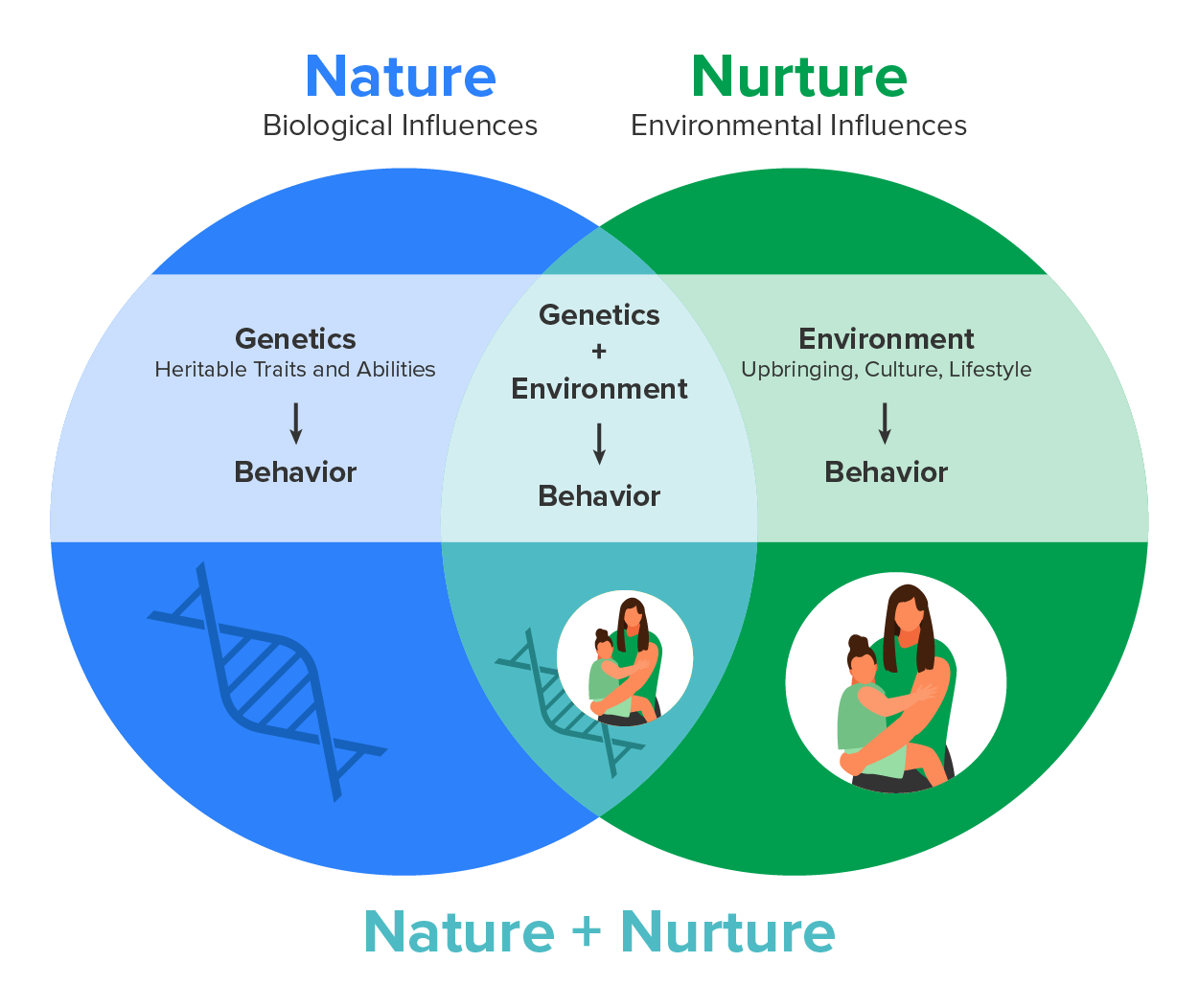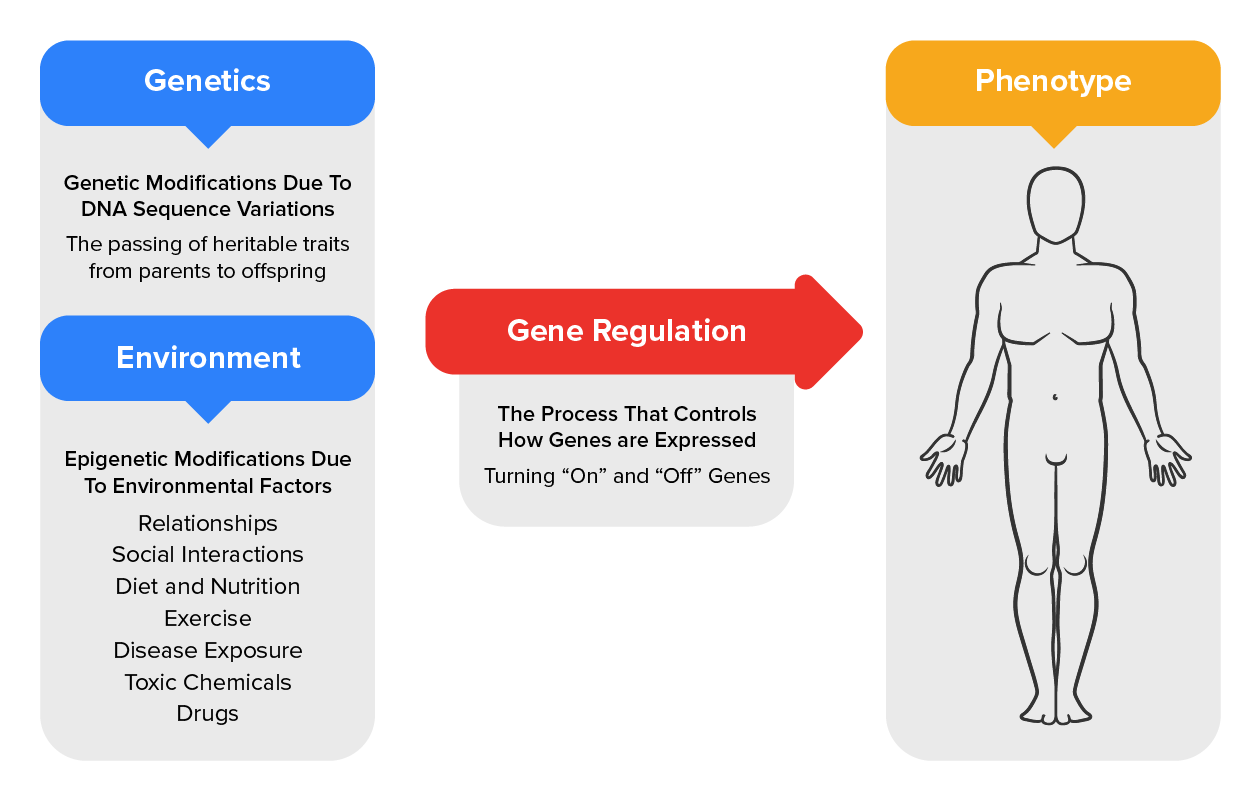Table of Contents |
That question is a longstanding enigma known in psychology as the nature vs. nurture debate. For decades, scholars have carried on the nature vs. nurture debate, which seeks to understand the extent to which our personalities and traits are the product of our genetic makeup and biological factors, and the extent to which they are shaped by our environment, including through our experiences with our parents, peers, and culture.
For any particular feature, those on the nature side of the debate would argue that heredity plays the most important role in bringing about a feature in an individual. Nativism is the extreme nature position in the debate. Nativism is the belief that human characteristics (e.g., personality, mental abilities, as well as hair color, eye color, skin pigmentation) are a result of evolution and variation between and across individuals is due to genetics.
The emphasis is on heritable traits, or traits that can be passed down from parents to offspring. The connection of a trait to nature is strengthened by when the trait appears—the earlier it appears, the more it is attributed to genetics.
Those on the nurture side of the nature vs. nurture debate, however, would argue that one’s environment is most significant in shaping the way we are. Empiricism is the extreme nurture position. Empiricism is the belief that the human mind is a blank slate at birth (also known as tabula rasa), and an individual’s experiences fill-in this blank slate. If we take on this position of the nature-nurture debate, then any psychological and behavioral characteristics are a result of learning. The only biological aspect is related to maturation; otherwise, how you are raised governs infant and child development. This debate continues in questions about what makes us masculine or feminine (Lippa, 2002), concerns about vision (Mutti, Zadnik, & Adams, 1996), and many other developmental issues.

Now that you are familiar with the nature versus nurture debate, you might be wondering “is there a position that incorporates both?” There can certainly be an interaction between nature and nurture, and this perspective is called epigenetics. Epigenetics is the study of how environmental experiences affect genetic activity, without changing the genetic makeup of an individual. They are reversible changes, and modify how our body reads our genetic material (like when a gene is turned on or off).
In epigenetics, we recognize that while we are all born with specific genetic traits inherited from our parents, such as eye color, height, and certain personality traits, there is also a deep interaction between our genes and our environment. Our unique experiences in our environment influence whether and how particular traits are expressed, and at the same time, our genes influence how we interact with our environment (Diamond, 2009; Lobo, 2008). There is a reciprocal interaction between nature and nurture, as they both shape who we become, though the debate continues as to the relative contributions of each.
Most scholars agree that there is a constant interplay between the two forces. It is difficult to isolate the root of any single behavior as a result solely of nature or nurture, and most scholars believe that even determining the extent to which nature or nurture impacts a human feature is difficult to answer. In fact, almost all human features are polygenic (a result of many genes) and multifactorial (a result of many factors, both genetic and environmental). It is as if one’s genetic make-up sets up a range of possibilities, which may or may not be realized depending upon one’s environmental experiences.
EXAMPLE
A person might be genetically predisposed to develop diabetes or other chronic conditions, or the person’s lifestyle (e.g., poor diet, lack of exercise) may help bring about the disease.Developmental psychologist Gilbert Gottlieb has suggested that genetics and environment interact to affect gene expression and developmental outcomes. An example of this is sickle cell anemia, a genetic disorder that causes abnormal blood oxygen levels due to red blood cell characteristics. An individual with sickle cell anemia can experience a sickle cell crisis when oxygen deprivation occurs, which can cause health complications. The environment of an individual with sickle cell anemia will affect that individual’s phenotype, affecting gene expression and developmental outcomes (Gottlieb 1998, 2000, 2002).
The following illustration shows how genetics and environmental influences combine to create a unique phenotype for each individual. Phenotype refers to an individual’s inherited physical characteristics and observable traits, such as height, eye color and blood type. A person’s phenotype is determined by both their genetic makeup (genotype) and environmental factors. A person’s phenotype and genotype are determined by their chromosomes.

There are various types of epigenetic changes that can occur. Consider these three:
Source: THIS TUTORIAL HAS BEEN ADAPTED FROM LUMEN LEARNING'S LIFESPAN DEVELOPMENT. ACCESS FOR FREE AT https://courses.lumenlearning.com/wm-lifespandevelopment/. LICENSE: CREATIVE COMMONS ATTRIBUTION 4.0 INTERNATIONAL.
REFERENCES
Centers for Disease Control and Prevention. (2022, August 15). What is epigenetics? Centers for Disease Control and Prevention. Retrieved December 30, 2022, from www.cdc.gov/genomics/disease/epigenetics.htm
Centers for Disease Control and Prevention. (2022, August 18). What is sickle cell disease? Centers for Disease Control and Prevention. Retrieved December 30, 2022, from www.cdc.gov/ncbddd/sicklecell/facts.htm
l Diamond A. The interplay of biology and the environment broadly defined. Dev Psychol. 2009 Jan; 45(1):1-8.
Gottlieb, G. (1998). Normally occurring environmental and behavioral influences on gene activity: From central dogma to probabilistic epigenesis. Psychological Review, 105, 792-802.
Gottlieb, G. (2000). Environmental and behavioral influences on gene activity. Current Directions in Psychological Science, 9, 93-97.
Gottlieb, G. (2002). Individual development and evolution: The genesis of novel behavior. New York: Oxford University Press.
Lippa, R. A. (2002). Gender-related traits of heterosexual and homosexual men and women. Archives of sexual behavior, 31(1), 83-98.
Lobo, I. (2008) Environmental influences on gene expression. Nature Education 1(1):39
Mutti, D. O., Zadnik, K., & Adams, A. J. (1996). Myopia. The nature versus nurture debate goes on. Investigative Ophthalmology & Visual Science. Retrieved May 03, 2011, from www.iovs.org/cgi/reprint/37/6/952
National Human Genome Research Institute. (n.d.). Talking Glossary of Genomic and Genetic Terms. Genome.gov. Retrieved January 4, 2023, from www.genome.gov/genetics-glossary/
Newton, R. (n.d.). Genetics and Heredity. Human Growth and Development. Retrieved January 7, 2023, from pressbooks.pub/mccdevpsych/chapter/2-2-genetics-and-heredity/